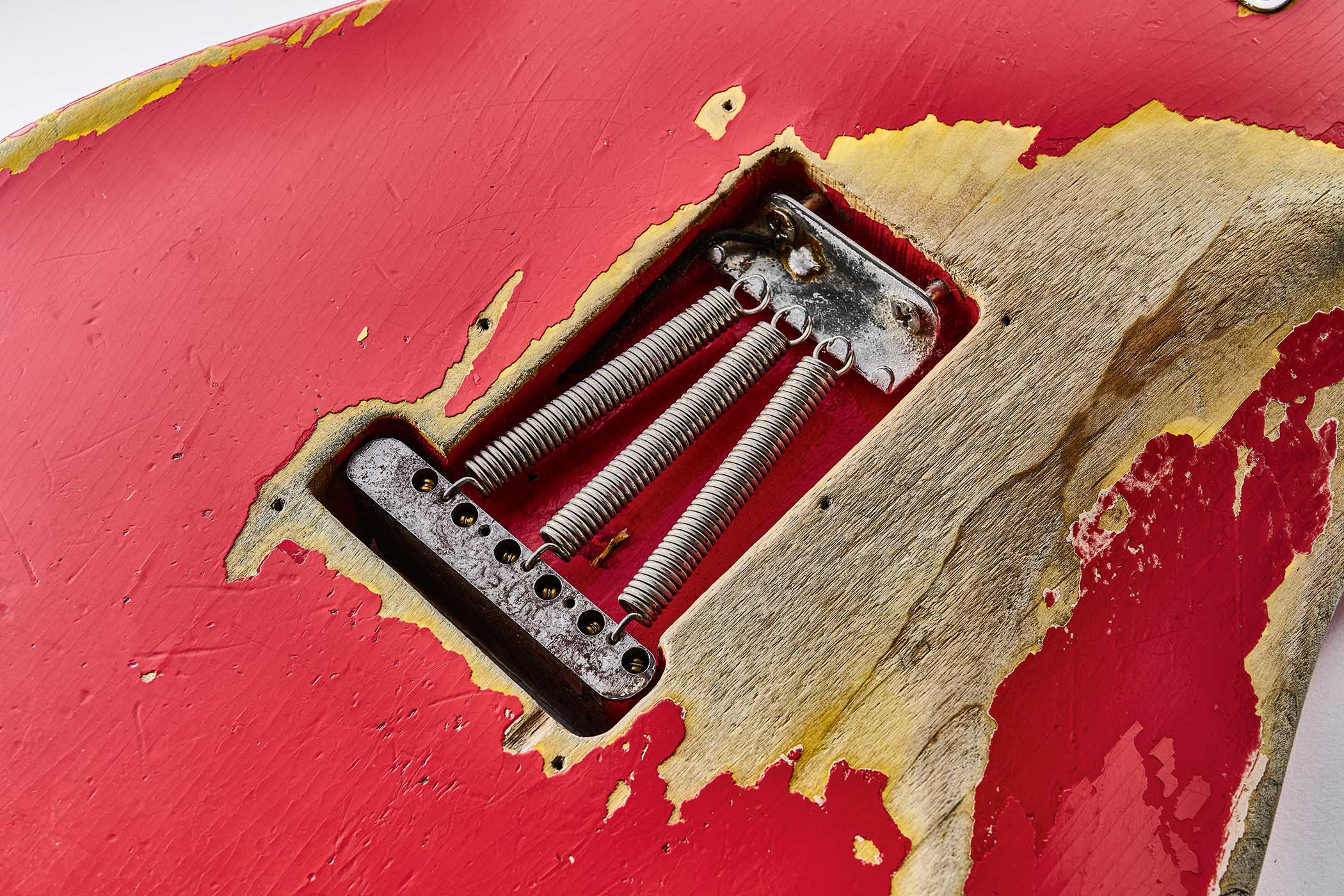
Steve Clarke has one of the best – but most exacting – jobs in the vintage guitar world. The author of Famous Frets is Bonhams’ authenticator for guitar collections such as Gary Moore’s and also sympathetically prepares the guitars for auction.
Having featured guitars for major auctions such as the much-publicised sale of Rory Gallagher’s Strat, his workbench is no stranger to high-profile instruments. But Gary Moore’s ‘Red Strat’ is surely up there with anything he’s examined before in terms of iconic electric guitars.
This has led some to theorise, over the years, that the relatively milky red that forms the visible majority of the guitar’s paint today was applied over a bolder red finish that lies beneath – plausibly, some have suggested, a Fiesta Red sprayed over the less commercially popular Dakota Red to factory-convert the guitar to a more saleable finish.
Steve says, though, that however tempting any ‘sunburst’ theories may seem to some, they were not borne out by his close inspection of the Strat.

“Now, the interesting bit for me is that, probably like yourself, I’d heard these rumours that ‘it’s even been a sunburst’… I’ve read that one, too. But I could find no evidence of this. I peeled back a little bit of the copper tape underneath [applied as shielding for the electronics] and you could see, consistently, that all over the guitar – from the front pickup to the back where the bridge would be – was this sandy-colour undercoat.
“Because they did spray what you call Desert Sand as an undercoat. Sometimes they didn’t, but with the red guitars, they’d either use a white or a Desert Sand [base coat] on earlier examples.”
“This being relatively early [for a custom colour red guitar], it would fall in line with that. And that was all over. But I couldn’t see any flecks of black [sic; ie, dark brown from a ’Burst] anywhere.
“So I couldn’t see any [evidence of] sunburst or anything like that. That yellowy colour [visible at the fringes of scratches on the guitar’s body] might have been why people have said, ‘Oh, it’s been sunburst,’ and I’ve even read that in a magazine ages ago.
“But I think that’s the Desert Sand undercoat because it’s all over. If you take the strap buttons off, you’ll see it there and in the bridge cavity and around that area – it’s all over the guitar. And you see it on the top where there’s a big scratch.”
Steve goes on to explain that the Fender custom colour known as Fiesta Red is something of a shifting sand itself. Not only was it likely not to have been consistently calibrated as a hue, especially in the early years of its use at Fender, he says it can be among the most volatile of colours in terms of vulnerability to fading or discolouration due to environmental factors.
“It’s the most reactive paint you can have to UV exposure, and heat [from contact with the player’s body] can accelerate that and actually change the colour.”

Steve’s inspection also threw up other interesting points. Graham Lilley, Gary’s former guitar tech and road manager, has gone on record in the past to say the neck pickup was rewound by Seymour Duncan in 1998, while the middle pickup was replaced by a Seymour Duncan Antiquity single coil in 2003.
However, Steve found that the guitar, in its current configuration, has a different pickup in the middle today.
“My notes and photograph show it now to be a Lindy Fralin Blues Special. The wire has been cut instead of desoldered and black insulation tape has been wrapped around the Fralin and joined to the remaining wire! I also found an original Stackpole pot inside the case in an envelope – the number is 304-6043. This is very likely the original one fitted as it was very stiff to turn until I did some work on it.”
Gary Moore’s Original Red Strat vs Fender’s Custom Shop Replica – YouTube

Beyond these points on the finish, pickups and wiring, Steve says the neck, which is stamped 11/60, is very playable even today.
“It’s a very nice guitar to play, really nicely set up. The action was pretty good straight out of the case. These things have a uniqueness about them.
“I had a ’56 Strat a few years ago, a George Harrison ’56 Strat, and that was so vibrant. And I’ve picked up others where they’re not; they were like a piece of plywood. But not this one. Lovely guitar, got a character all of its own, and I thought it was just wonderful.”
- This article first appeared in Guitarist. Subscribe and save.

